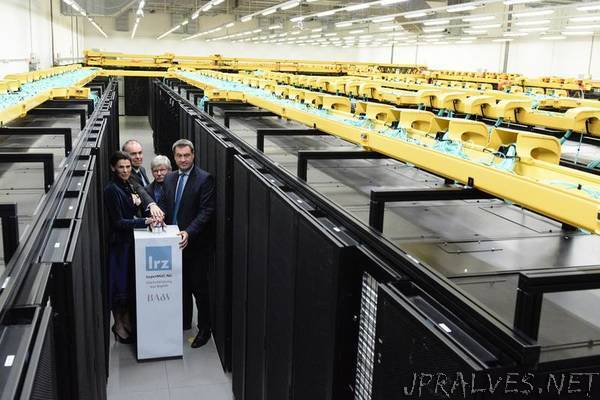
“Experiments and simulations frequently produce enormous volumes of data. The new high-performance computer SuperMUC-NG at the Leibniz Supercomputing Center (LRZ) in Garching is currently the fastest computer in Germany, assisting scientists at the Technical University of Munich (TUM) in handling enormous quantities of data. Today, the new supercomputer was put into operation for the first time.
Disaster control, personalized medicine, and the origins of the universe — these are just a few of the research areas for which scientists at TUM have been using the computing power of the Leibniz Supercomputing Center (LRZ) of the Bavarian Academy of Sciences and Humanities over the past years. The ‘next generation’ of the high-performance computer SuperMUC, which was launched in 2012, was now inaugurated in the form of the SuperMUC-NG. In the future, the new supercomputer will provide all the researchers who were pushing its predecessor to its limits with significantly improved computing power.
A WORLD-CLASS SUPER-COMPUTER
SuperMUC-NG grants researchers complete freedom when using their own software and visualization environments and supports them in sharing their results with others, as the computer is connected to cloud components.
Boasting a peak performance of 26.7 petaflops/s — which translates into 26,700,000,000,000,000 floating point operations per second —, the new super-computer is not only the fastest computer in Germany but one of the fastest worldwide. More than 300,000 processor cores with 700 terabytes of central memory and 70 petabytes of disk storage open up completely new opportunities for numerical simulations. SuperMUC-NG can also handle extremely large amounts of data — so-called ‘big data’ — that are accumulated during experiments and simulations.
A FOUNDATION FOR CUTTING-EDGE RESEARCH
Today, Bavaria’s Minister of State Dr. Markus Söder ceremonially inaugurated the computer by turning it on for the very first time, with the Bavarian Minister of Science, Professor Marion Kiechle, and the President of the Bavarian Academy of Sciences and Humanities, Professor Thomas Höllmann, in attendance.
“With this new supercomputer, we are creating a foundation for researchers and scientists all over the country to be able to conduct world-class cutting-edge research,” said Minister of Science Kiechle. Minister of State Söder emphasized that the new high-performance computer will provide completely new opportunities for the world of science and pave the way for the development of revolutionary quantum computers.
SIMULATIONS RANGE FROM THE EARTHQUAKE IN SUMATRA TO FLOOD FORECASTING IN BAVARIA
From 2008 to 2017, TUM Professor Arndt Bode served as the Chair of the Board of Directors of the Leibniz Supercomputing Center. He was a major contributing force in moving Germany to the forefront of the development of advanced computer architectures. Over the last years, TUM researchers have used the computing power of the LRZ for many successful research projects, including projects from the fields of cosmology and astrophysics, solid-state physics, and fluid mechanics but also from the fields of life sciences and disaster and environmental research.
The simulation of the Sumatra earthquake in 2004, for example, was considered a major scientific breakthrough. A team of scientists from TUM and the Ludwig Maximilian University of Munich (LMU) produced significant insights into the geophysical processes of the earthquake which triggered devastating tsunamis in many coastal regions of the Indian Ocean.
Researchers from TUM, the LMU, and the LRZ also conducted extensive simulations in collaboration with a Canadian team to study the effects of climate change in Bavaria. Using the supercomputer, they were able to determine how climate change affects precipitation and flooding events in Bavaria.”
